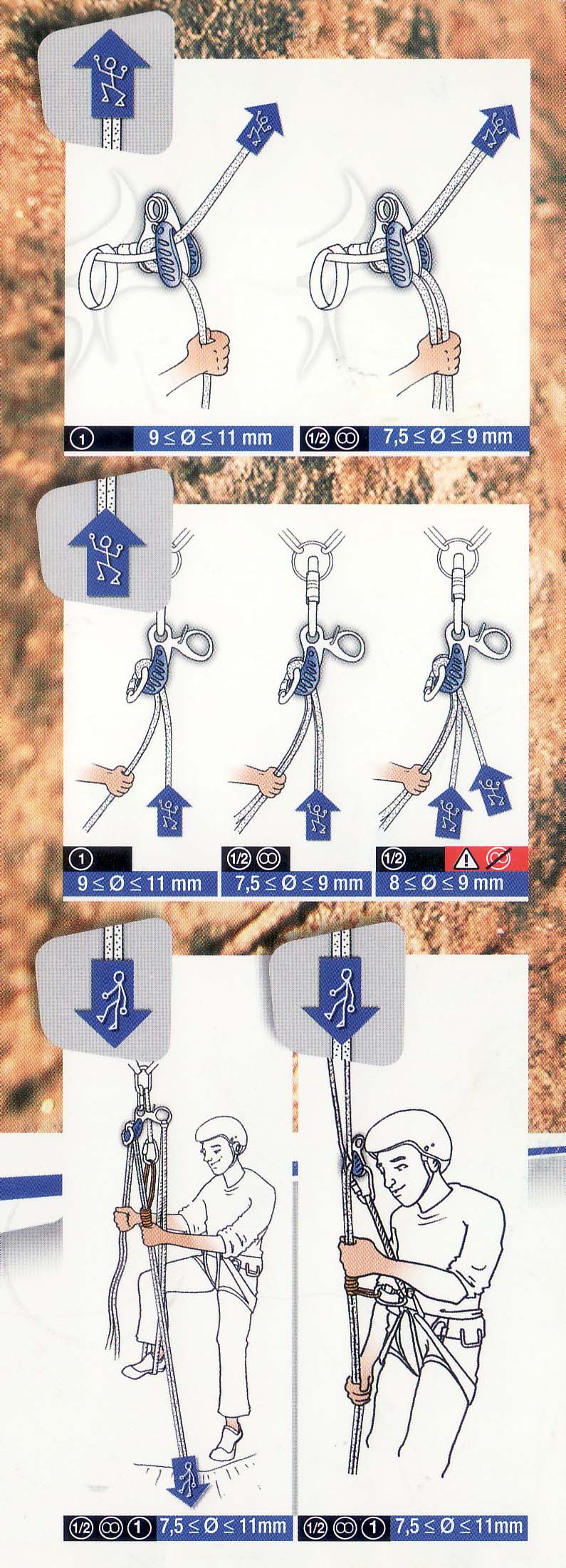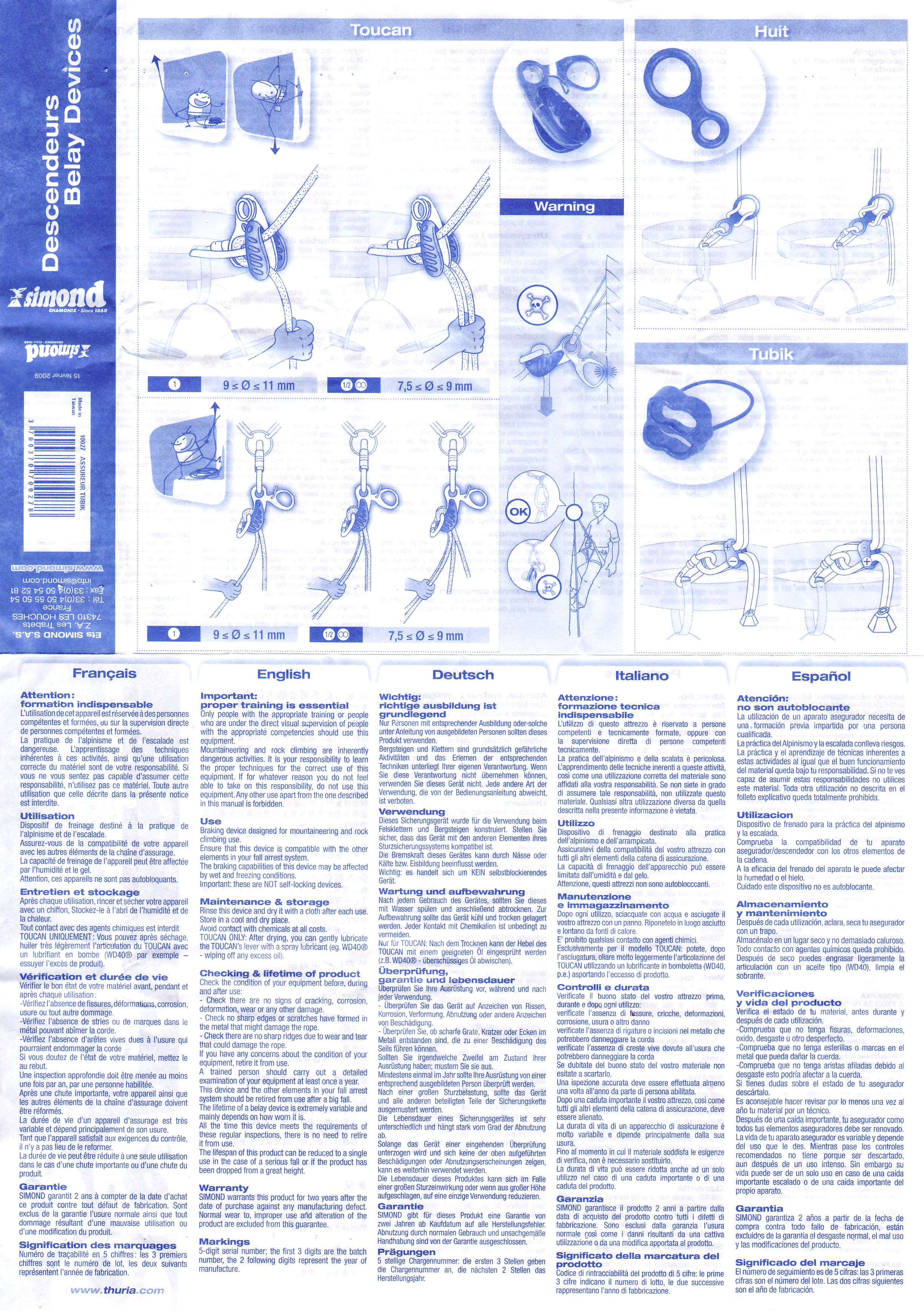Technical Details
 I bought my Toucan from Mountain Gear in 2006. I acquired another from Premiere Consignment, LLC on eBay in 2018.
I bought my Toucan from Mountain Gear in 2006. I acquired another from Premiere Consignment, LLC on eBay in 2018.
The body of the Toucan consists of two forged aluminum side
pieces riveted to a center rib formed by two pieces stamped from
1.9 mm. sheet aluminum. Each side piece creates a 14.3 mm
long, 15.8 mm. wide rope slot between itself and the center
rib. Five depressions on the outside and three on the inside of
each side piece lighten them somewhat. The central rib pieces
are flat except at the outer top end, where they flare slightly
to better define the rope slots. The other end of the slot has
a 20 mm. I.D. hollow rivet fitting through holes in the central
ribs and a pivoting keeper arm. The keeper arm has a large, roughly
D-shaped attachment hole. A spring-wire on the keeper arm tends
to force the keeper away from the main central ribs, should the
two be pushed together.
One side of the central rib is stamped with "TOUCAN"
outside the side piece, and with a climber icon and up arrow inside
the rope groove on the side near the keeper arm. The other side
of the central rib has a similar icon and arrow in the corresponding
place, and outside the side piece has "Simond," "min
2*Ø7.5," and "05578." One side of the keeper
arm is stamped with two arrows pointing to the D-shaped hole and
"0 kN" between them, while the other side is stamped
"Pat. Pend."
The origin of the name "Toucan" is rather obvious:
look at the photo.
The Toucan functions as a normal two-slot belay device. In
this case, one clips the keeper arm hole with the same carabiner
that the rope bight(s) passes through. The slots are longer than
the ones found on most Sticht Plate
Belayers or Tube Belayers, so
it does not provide as much friction. The slot size is similar
to that on the Cassin
#217 and the Kong
Gi–gi, two guide devices. The Toucan can also work well as
a guide’s device, using the round hole to attach to an anchor
and an auxiliary carabiner to set up an autostop belay (as done
with the Kong Gi–gi).
The connection between the keeper arm and the main body appears
weak, and the "0 kN" stamp supports my observation.
I am surprised that there is no counter-indication in the (quite
sparse) directions that came with the Toucan. My advice is to
treat the keeper arm as a no-strength component.
|
 |
Warning:
Never support a person or an important load from the keeper arm hole! |
 |
|
History
The Simonds were a family of man ybrothers working as blacksmiths and who lived in or near Les Bossons, France (near Chamonix). They made farming equipment and cowbells for generations, but gradually began to produce mountain tools for climbers coming from England to explore Mont Blanc.
The Simonds began making ice axes in the 1860s. At that time, their axes had no inscriptions. Eventually the brothers Adolphe (dates unknown) and François (1867-1946) began to mark the axes. head. began to dedicate his work to designing and producing mountaineering equipment such as ice axes and crampons while Adolphe focused on making cowbells and other items.
Francois’s son Claudius (1905-1984).started working in 1925. Under him, Simond soon became a global name in the world of high-altitude mountaineering equipment. After World War II, the business was named after him.
In 1960, Claudius’ son Ludger took over. Since around the 1975s, the ice axes moved to a mass-produced metal shaft, and the form of forged and handmade axes ceased to exist. Ludger built a new headquarters at the foot of Mont Blanc in 1988. He sold his company to Wichard in 2004. In 2008, Decathlon became the sole shareholder of Établissements Simond.
For far more content, use a larger monitor and a full-width window.
Hundreds of cell phone users complained and asked me to for a simpler, mobile friendly site. In particular, they wanted me to limit each page to a small number of pictures and minimize my use of text. This new site provides what they asked for.



